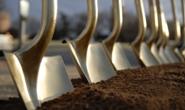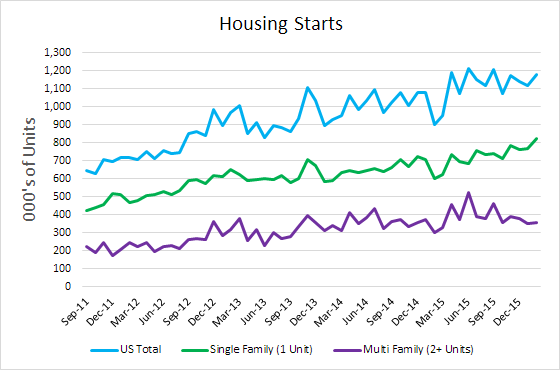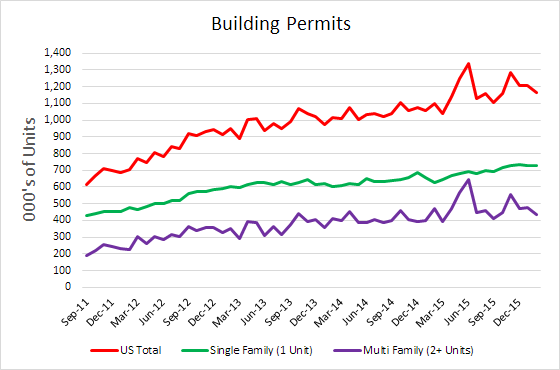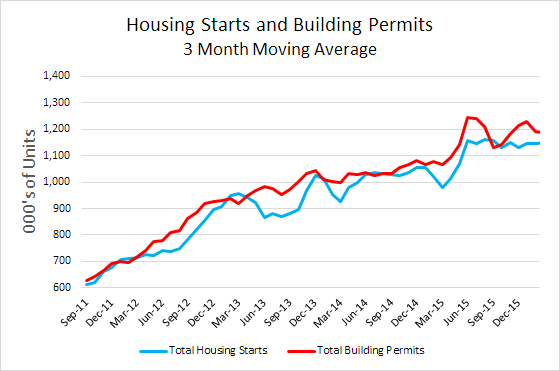Steel Markets

Single Family Housing Starts Rebound in February
Written by Sandy Williams
March 17, 2016
Housing starts jumped 5.2 percent in February led by an eight year high in single-family construction. After a slow start in January, the Commerce Department reports housing starts were at a seasonally adjusted annual rate of 1,178,000, up 5.2 percent from January’s revised rate of 1.12 million and 30.9 percent from February 2015.
Single-family construction surged 7.2 percent to an annualized rate of 822,000. Multi-family housing of 5 units or more increased 2.4 percent for an annualized rate of 341,000. Apartment housing has been a favored choice for young adults saddled student debt and little savings. The surge in single family housing potentially signals stronger confidence in the economy.

Building permit authorizations, an indicator of future construction, were down 3.1 percent from January due to a decline in multi-family permits. Permit authorizations were at a SAAR of 1,167,000, a 0.4 percent increase for single-family construction and a 9.1 percent decline for structures of 5 units or more.

“This month’s report is consistent with positive builder sentiment and other economic indicators showing that the housing market continues to recover at a gradual pace,” said NAHB Chairman Ed Brady, a home builder and developer from Bloomington, Ill.
“February’s single-family gains indicate that this sector is strengthening in line with our forecast,” said NAHB Chief Economist David Crowe. “As the U.S. economy firms, job creation continues and mortgage interest rates remain low, we should see further growth in housing production moving forward.”
Regionally, permits surged in the Northeast by 40.4 percent. The Midwest, West and South registered respective permit losses of 11.4 percent, 7.2 percent and 4.4 percent.

The chart above shows starts and permits on a 3 month moving average. Housing starts have been on a gradual rise since December. Permits hit a 3mma high in November and have been gradually declining since then. Both starts and permits have been generally trending upward since 2011.
Builder Confidence
Builder confidence for newly-built single-family homes was unchanged at 58 in the March National Association of Home Builders/Wells Fargo Housing Market Index.
“Confidence levels are hovering above the 50-point mid-range, indicating that the single-family market continues to make slow but steady progress,” said NAHB Chairman Ed Brady, a home builder and developer from Bloomington, Ill. “However, builders continue to report problems regarding a shortage of lots and labor.”
“While builder sentiment has been relatively flat for the last few months, the March HMI reading correlates with NAHB’s forecast of a steady firming of the single-family sector in 2016,” said NAHB Chief Economist David Crowe. “Solid job growth, low mortgage rates and improving mortgage availability will help keep the housing market on a gradual upward trajectory in the coming months.”
Builder perception of current sales conditions was unchanged at 65 while future sales expectations fell 3 points to 61. The buyer traffic index rose four points to 43.
The 3mma for the regional HMI scores showed the Midwest gaining one point to score 58 while the South remained unchanged at 49. The West fell 3 points to 69 and the Northeast fell one point to 46.
The NAHB/Wells Fargo HMI is a monthly survey that measures builder perceptions of current single-family home sales and sales expectations for the next six months. Scores are seasonally adjusted where any number over 50 indicates more builders view conditions as good than poor.

Sandy Williams
Read more from Sandy WilliamsLatest in Steel Markets

CMC looks beyond Arizona micro-mill woes to long-term viability of construction mart
Despite the economic and geopolitical upheaval of the last five years, CMC President and CEO Peter Matt points out that the construction market has been an essential element of the way forward.

US importers face stricter rules under revamped S232 tariffs
“CBP expects full compliance from the trade community for accurate reporting and payment of the additional duties. CBP will take enforcement action on non-compliance," the agency said in a March 7 bulletin.

Steel exports rebound in January
US steel exports recovered to a five-month high in January after having fallen to a two-year low in December. This growth follows four consecutive months of declining exports.

Construction spending drops marginally in January
Construction spending edged down slightly in January, slipping for the first time in four months. The US Census Bureau estimated spending at a seasonally adjusted annual rate of $2,196 billion in January, down 0.2% from December’s downward revised rate. The January figure is 3.3% higher than a year ago. January’s result, despite the slight erosion, […]

HVAC equipment shipments slow in December but strong annually
Shipments of heating and cooling equipment in the US fell to an 11-month low in December, according to the latest data released by the Air-Conditioning, Heating, and Refrigeration Institute (AHRI).
